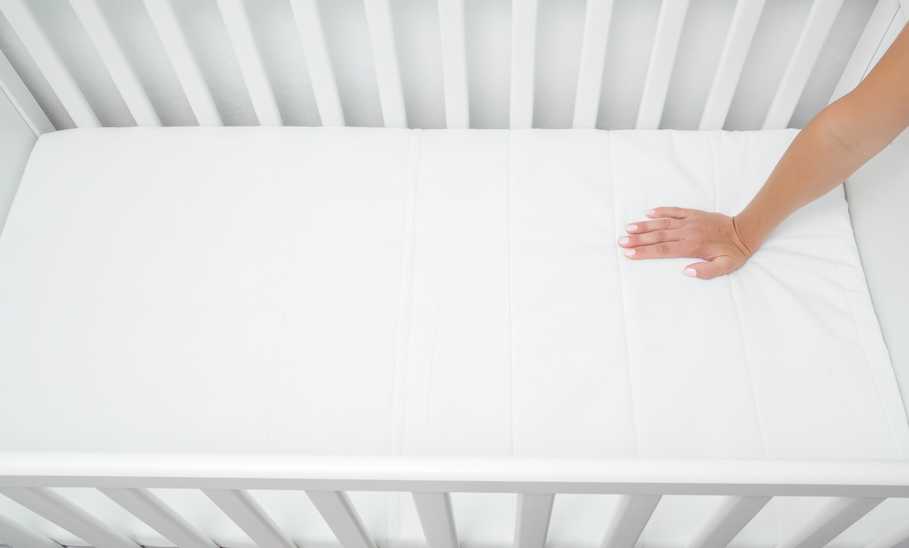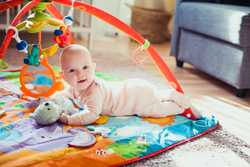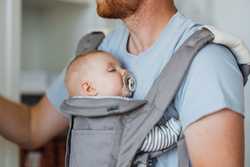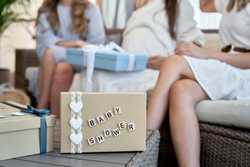What Size is a Crib Mattress and More Vital Info About Your Baby’s Sleeping Space

Our evaluations and opinions are not influenced by our advertising relationships, but we may earn a commission from our partners’ links. This content is created by TIME Stamped, under TIME’s direction and produced in accordance with TIME’s editorial guidelines and overseen by TIME’s editorial staff. Learn more about it.
If you’re a new parent, you may be tasked with finding a crib mattress for your new crib. What is a crib mattress and how does it differ from a regular one? A crib mattress is a firm and supportive mattress specifically designed for babies’ cribs. It provides a safe and comfortable sleeping surface for infants and toddlers. The right size mattress is important for a baby's safety. If a mattress is too small it can leave gaps between the mattress and crib frame which could create a suffocation hazard if a baby gets stuck. Conversely, a mattress that's too big can also be dangerous, as a baby could use the extra space to climb over the crib rail. Here, we talked to baby sleep and safety experts to learn more about crib mattresses and what to know when shopping for one.
“A standard crib mattress 27 ¼ inches (69.2 centimeters) by 51 5/8 inches (131.1 centimeters), but not thicker than 6 inches (15.2 centimeters),” says sleep consultant Lauren Weintraub. These are the federal regulations for crib mattresses. These regulations help keep your baby safe, in addition to reducing the risk of your baby getting stuck in between the crib rails and crib mattress.
Lisa Trofe, Executive Director of the Juvenile Products Manufacturers Association (JPMA) says that there should be no more than a half-inch gap between the mattress and the crib's sides.

“There are many different variations in crib sizes and styles, and many variations of bassinets and pack n plays,” says certified sleep consultant Alisha McCarthy. “Many of the clients that I work with who live in smaller living spaces, or apartment style/city living tend to lean more toward the bassinet or mini crib option in those first six months of a little one’s life,” she adds. As babies get older, it’s important to transition to a standard full size crib, she says. “Babies and toddlers love to move all around in their sleeping space; it's how they find their ‘comfy’ spots,” she explains. “Therefore, it is important as they get older and bigger we expand to a full size crib to accommodate those little movers.”
“Beyond full size cribs, parents and caregivers have many options when it comes to choosing a crib or safe sleep product. This includes portable cribs, mini cribs, play yards, and more,” Trofe says. “Many of these non-full size options come with a mattress pad or mattress, and JPMA recommends you follow the manufacturer’s instructions for installing and using the included sleep surface. As the American Academy of Pediatrics (AAP) recommends a flat, firm sleep surface, it is important to never add an additional mattress or padding to these products,” she explains.
Trofe says that if you need to replace a mattress or mattress pad for a sleep product, select the one recommended by the original manufacturer to ensure it fits correctly, or make sure to purchase a mattress pad or mattress recommended for the specific brand and model number.
Crib mattresses typically come in one standard size to ensure a safe and proper fit within the crib.
While these are uncommon, there might be slight variations within the standard size due to manufacturing tolerances. These variations should be minimal and still ensure a safe fit in most standard cribs.
For mini cribs, there’s a smaller mattress size, typically measuring around 24 inches (61 centimeters) wide by 38 inches (96.5 centimeters) long.

These might be slightly thinner or lighter for portability, but should still meet safety standards. They’re typically the same size as mini crib mattresses. “A portable crib mattress is generally 38 inches (96.5 centimeters) x 24 inches (61 centimeters) while an oval mattress [for a bassinet] is 43 inches in diameter and 4 inches thick,” Weintraub says. “If using a non standard crib shape (not rectangular) it is best to use the specific mattress that comes with that crib as that is what has been tested with the crib and deemed safe.”
It’s important to have the correct mattress size for your crib for safety reasons, says Weintraub. All mattresses should fit snugly into the crib and be a firm mattress. “Coil spring mattresses are thicker than foam mattresses. The mattress should be just smaller than the measured interior of the crib,” she says.
Crib mattresses that don't fit snugly within the crib frame pose several safety hazards to babies. Here's a breakdown of the main risks.
This is the most serious risk associated with gaps between the mattress and crib. A baby can roll or scoot and get their head wedged in the gap, potentially leading to suffocation. Even a small gap can be dangerous for a young child.
A baby's arms, legs, or even their entire body could become trapped in a gap between the mattress and the crib frame. This can be uncomfortable and frightening for the baby, and could also restrict their breathing.
If a baby gets stuck in a gap or tries to climb out of the crib using a gap as leverage, they could fall and injure themselves.
There should be no more than a half-inch gap between the mattress and the crib's sides, Trofe explains. “For a simple fit check, you shouldn't be able to fit more than two adult finger widths between the mattress and the crib's slats or walls all the way around,” she adds. “Additionally, when you set the mattress at its highest level (for the youngest infants), there should be at least 20 inches between the top of the mattress and the crib's top rail.”
Trofe says never to use ill-fitting mattress protectors or sheets. “Linens can shift off the mattress due to being too tight or too loose causing suffocation and entrapment hazards,” she says. For a full size crib mattress, these linens are a standard size and should be marked as such on their packaging. “For all other sizes and shapes of mattresses and mattress pads, JPMA recommends you purchase directly from the manufacturer of the original sleep product. If the manufacturer does not offer such accessories, make sure to compare the dimensions of the mattress/mattress pad to the sheets and mattress protectors prior to purchasing.”
Make sure the fitted sheet is securely on the mattress, Weintraub says. “It is not advisable to put a top sheet, quilt or any other blanket in a crib for suffocation purposes,” she says. “Sleep the baby in one layer more than you would sleep, which usually would mean t-shirt weight pajamas and a sleep sack,” she says.
If you want a bumper, you can use it for decor purposes only, Weintraub says, as they’re a suffocation hazard should a head get caught. “If you're using a bumper, it should be placed on the outside of the bed,” she explains. “They do make mesh bumpers which aren't as aesthetically pleasing, but they hold pacifiers in and are less likely to allow limbs or a head to get caught.” Once a baby is standing in the crib, you should take the bumper completely off as he or she could use it to step on and then fall out of the crib.
Trofe says that when it comes to selecting a crib or mattress for your baby, JPMA suggests choosing one from a JPMA member. “By doing so, parents and caregivers can have peace of mind that they’re purchasing from a trustworthy company. JPMA also offers a Certification program for these categories. Products or product packaging with the JPMA Certification Seal have been tested annually to all federal and state regulations, the voluntary ASTM standard, and other major retailer requirements at an independent, CPSC-accredited laboratory.”
Even though there's no specific firmness requirement in current crib mattress standards or federal rules, JPMA recommends selecting a firm mattress for your baby's sleep, Trofe says. “Some mattress brands even offer a ‘dual’ mattress with an extra firm side for infants and a softer side for older kids and toddlers,” she says. If you opt for this type of mattress, make sure to use the correct side and follow the manufacturer's instructions carefully.
For any crib mattress, always make sure to follow the manufacturer's instructions for how to install and use the mattress, and stick to well-known brands. “It's worth knowing that all baby products, including crib mattresses, must meet strict federal safety standards, covering aspects like fire resistance and the use of safe materials. This means that crib mattresses are now safer than ever,” Trofe says.
“A baby doesn't need anything in their crib space, and we want to avoid anything that can make the space unsafe,” Vice President of Clinical Research at Nanit, Natalie Barnett, says. “I know it's tempting to make the crib super-cute and insta-worthy with bumpers, cushions, and stuffed animals, but they can all be a suffocation hazard for your baby. That includes baby loungers,” she explains. Barnett notes that these devices are not safe for a baby to sleep unsupervised, and she would never recommend having a baby lounger in the crib space.
The crib mattress should be made specifically for the size of your crib, Barnett says. “You do not want any space between the mattress and the crib slats, or the baby can get little limbs stuck down there or wedge their whole body down the side of the crib. The crib sheet should also be specifically made for the crib, tight-fitting, and made from a natural, breathable fabric.”
As soon as the baby can stand or sit up, lower the mattress, Weintraub says.
While mobiles over a changing table is a good idea, you shouldn’t have one over a crib. “A baby can pull on it which causes it to fall and hit the baby causing an injury,” Weintraub says. “Mobiles with strings can also strangle or cut circulation off.”
Barnett says that this includes curtain or blind cords and electronic device cords, e.g., white noise machine, baby wipes warmer, humidifier, etc. “Hanging cords are very dangerous and can quickly and easily get around a baby's neck or limbs,” Barnett notes. “The amazing thing about Nanit is that you can mount the camera directly above the crib in a safe way, so it is right near the crib, and you do not need to worry about those loose cords.”
Understanding crib mattress size and choosing the correct one is absolutely crucial for your baby's safety. Here's why:
A too-small mattress can leave gaps between the mattress and crib frame. A baby could get stuck in these gaps, potentially leading to suffocation or entrapment. A gap could also be used for climbing, increasing the risk of falls and injuries.
The right size mattress creates a snug fit within the crib, promoting a safe sleep environment for your baby.
Remember, there's a standard size for crib mattresses for a reason. It ensures compatibility with most cribs and prioritizes your baby's safety. Always check the fit of the mattress in your specific crib, and never force a mattress that doesn't fit snugly.
The information presented here is created by TIME Stamped and overseen by TIME editorial staff. To learn more, see our About Us page.



